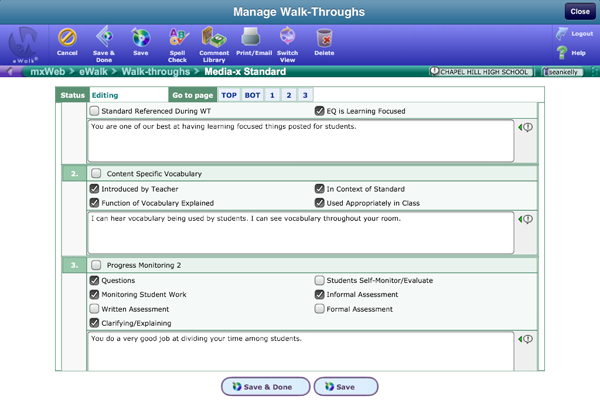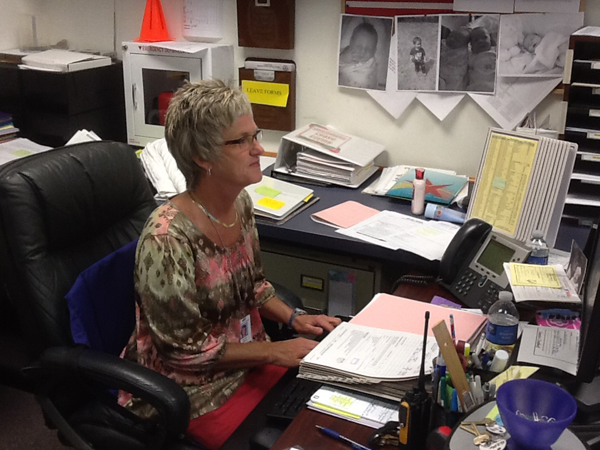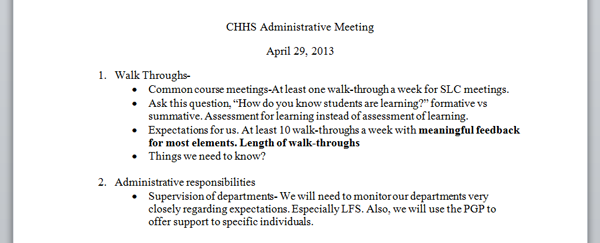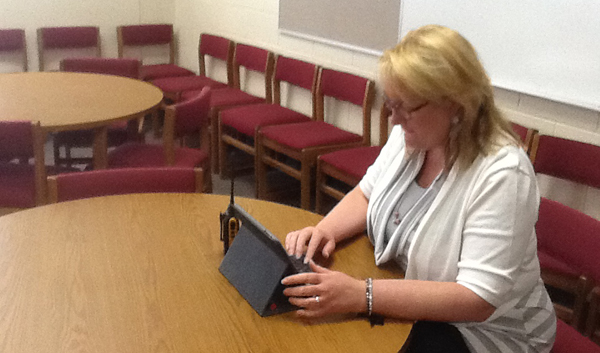This is the third installment of my series on transforming your school by using classroom walkthroughs with eWalk. If you missed the first two installments, you can catch up here: Part one and Part Two.
Once you have planned your eWalk program and developed your initial template, you will be well served to establish some non-negotiables regarding your eWalk protocols so that your implementation procedures are smooth and purposeful.
Establish eWalk Protocols
a)Â Â Â Â Â Â Â Â Focus on Quality. Quality classroom walkthroughs require patience, precision, and commitment from the observer. If your focus is to complete a high number of walkthroughs, you will miss a great opportunity to provide a meaningful experience for your teachers. I learned this lesson the hard way. My first year of conducting walkthroughs was nothing more than three to five minute visits and a bunch of checked boxes. My eWalk protocols were inefficient and ineffective.
Teachers want you in their rooms to see the wonderful things they are doing. Teachers also appreciate your praise when you observe them performing in an effective manner. If you focus on the quality of the walk-through and not the quantity of walkthroughs, your eWalk program will provide teachers with experiences that will enhance their effectiveness and increase their success.

Teachers appreciate positive comments regarding their teaching
b)        Number of Walk-Throughs. Determine the number of walkthroughs to be conducted each week. Limit this number to how many quality walk-throughs you can complete each week. Conducting walk-throughs that are of low quality is a waste of your time and more importantly a waste of the teacher’s time. I suggest that your focus be on setting a number that will allow you to spend quality time in the classroom and offer detailed feedback to teachers on most of the elements contained in your template.
I began my eWalk program with a requirement of 15 walkthroughs per week from each observer. I quickly realized that visiting 15 classrooms a week and providing quality feedback to teachers was not something we could accomplish. We have since lowered our number to ten walkthroughs a week and have been much more successful at providing our teachers with a quality walk-through experience.
c)Â Â Â Â Â Â Â Â Meaningful Feedback. Make a commitment to provide teachers with meaningful feedback for a majority of the elements contained in your template. Providing meaningful feedback to teachers regarding their classroom performance is critical for them to grow professionally. I would suggest that you initially focus on the positive. Spend a few weeks writing positive comments about what you observe in the classroom. Make the initial walkthroughs all about how great teachers are and how you appreciate what they are doing for their students. When teachers receive six or eight walkthroughs that focus on the positive aspects of their class, they will become comfortable with you and with your eWalk program.
Feedback offered to teachers should be of the highest quality and foster reflection from teachers regarding their professional practice (Feeney, 2007; Gray & Streshly, 2008; & McGill, 2011).
Once you have demonstrated to your teachers that the goals of the eWalk program is to support their teaching and provide them with authentic feedback, you can begin writing comments that encourage them to reflect on those areas that need growth. Teachers will be much more receptive to your future comments encouraging them to reflect and grow professionally once you have demonstrated to them that you are sincere about their performance levels.
We have initiated a dialogue among professional educators and created an opportunity for teachers to reflect on their professional practice.
d) Â Â Â Â Â Â Â Email Completed Walk-Through. Our protocols require us to email the completed walk-through template with feedback back to teachers within 48-hours of the classroom visit. We feel very strong that there should be a sense of urgency with regard to providing teachers with the completed walk-through. Most teachers will be expecting some form of a response regarding our visit to their classroom. We feel teachers should be respected regarding the amount of time that passes between the classroom visit and the time they receive the completed walk-through.
Many of our teachers are anxious to receive their walk-through. They anticipate the return of the template and look for our comments so they can evaluate whether or not they feel our comments are valid. If teachers feel we are not accurate with our comments, they will often reply with an explanation or ask questions to seek a better understanding of the comment. Either way, we have initiated a dialogue among professional educators and created an opportunity for teachers to reflect on their professional practice.

Assistant principal Jennifer Baggett emailing a completed walk-through back to the teacher.
e)Â Â Â Â Â Â Â Â Establish A Time to Discuss Walk-Through Data. Establish a time each week to discuss walk-through data with significant participants. We meet each Monday as an administrative team and the very first item we discuss is walk-through data from the previous week. We discuss the positive things we have seen in the classroom from the previous week as well as things we feel need some attention. This allows us to closely monitor classroom practice. From these critical conversations regarding classroom practice we will establish a plan of action for those incidences that require some attention and develop opportunities to praise those teachers who are doing great things in the classroom.
We also meet with teachers when needed. We not only meet with teachers to discuss opportunities for professional growth when we have concerns but also to provide praise and a well-deserved pat on the back when we observe teachers doing great things. We have no set schedule regarding our conversations with teachers. We meet when necessary regarding concerns so that they are addressed immediately. We also take every opportunity to praise teachers for a job well done.
Conversations with significant participants are a critical component of our eWalk program. Data collected from walkthroughs are of little use if action does not result. Your eWalk program can transform your school if you make a commitment to the process. If you conduct effective walkthroughs, provide teachers with quality feedback, and act upon the collected data the possibilities for school improvement are endless.

Administrative meeting agenda dated April 29, 2013. The first thing we discuss each week is walk-through data.
Implementation
a)Â Â Â Â Â Â Â Â Remind Teachers of Visits to Their Classroom. Remind teachers that classroom visits will increase. We make every attempt to keep our teachers informed. We do not want teachers to be surprised when we begin visiting their classrooms more often. It is our sincere desire to make the eWalk program a comfortable process that eventually becomes embedded in our school culture.
b) Â Â Â Â Â Â Â Purpose and Goals of the eWalk Program. I would suggest that you make every effort to continuously remind your teachers of the true purpose and goals of the eWalk program during the first two years of the process. It is critically important for teachers to be reminded that the purpose and goals of the program is to support their professional practice and provide them with opportunities to reflect and become better educators. If teachers begin to lose trust in you or the eWalk program your process will not be as effective or efficient as it should be.
c)Â Â Â Â Â Â Â Â Begin Your Visits. You have worked hard and created a solid foundation for your eWalk program. Devote some time to get out of the office and in classrooms. You will be amazed at how receptive teachers and students are going to be when you begin your visits. Our students do not even look up anymore when we enter the room. Visiting classrooms and being out in the building has taught me so much about my school. I was truly amazed at how ignorant I was regarding the great things that were taking place in my school.

Assistant Principal Stefanie Stinchcomb using her iPad to conduct a walk-through observation.
d)Â Â Â Â Â Â Â Â Initial Analysis of eWalk Process. I would suggest you make an initial analysis of your eWalk process one week after you begin visiting classrooms. Consider logistical information regarding your visits to the classroom. Were you able to visit the agreed upon number of classrooms? How long were you able to stay in the room? Does your template work? Is your template efficient? Is your template effective for the data you wish to collect? Are you able to make comments? What level of quality is demonstrated in your comments? Do your comments praise teachers? Are the majority of your comments positive? Are you able to upload your completed template to the Media-X website? Have you reviewed your initial data on the Media-X/eWalk website?
I realize consideration of the logistical information appears to be a rather overwhelming task but it’s not. It is actually a fairly simple endeavor. The goal of your initial analysis should be to ensure everything works in the manner you desire. If it does not or there are little adjustments that need to be made to either the process or the template it is very beneficial to make that discovery now and not after you have collected several weeks of eWalk data.
e)Â Â Â Â Â Â Â Â Initial Analysis of eWalk Data. Two weeks of eWalk data should be enough to conduct your initial analysis. Take a look at your data to see if it makes sense to you. Can you see the beginnings of any patterns? Are you seeing anything more than two or three times? Have you noticed any specific areas that are of interest? Look at your data and decide if this is the information you want. If the data looks good to you, continue. If the data does not look like it will be useful, look to make some changes to either your program or your process. Useless data is a waste of time.
f)Â Â Â Â Â Â Â Â Fine Tune if Necessary. Week two is an optimal time to fine tune your eWalk process. Week two has allowed you time to conduct enough walk-throughs for preliminary patterns to emerge. There has also been enough time to measure the accuracy of your process. You should be able to discern after week two if your eWalk program is going to collect the type of data you desire. Week two is also early enough to make any changes you feel are appropriate to refine your program.
g)        Allow Your Program time to Mature. Allow your eWalk program and your walk-through process time to mature in your school. Now that you have created a solid foundation for your program, don’t be too quick to make big changes. Believe in your process and allow time for the data to provide you with actionable information regarding what exactly takes place in your building. As time passes, you will begin to see and experience opportunities you had never imagined. Collected data and the conversations that arise among professional educators initiated from your eWalk program have the power to transform your school.
h)        Be Careful of the “Gotchaâ€. In the beginning, be reminded that you want to avoid teachers having the perception that the eWalk program and the walk-through process is a “gotchaâ€. I cannot emphasize enough how important it is to focus on the positive as you begin to implement your program. You want to build trust with your teachers regarding your program and your process so that as you begin offering comments regarding opportunities for teachers to reflect and grow in their practice there is a level of trust that has been formed. If teachers trust that your comments are sincere attempts to help them grow professionally, they will be much more receptive to reflecting upon your comments and improving as educators. If you fail to build this level of trust, teachers will struggle with the true purpose of your program.

It will be unfortunate if your teachers associate this guy with your eWalk program.
“I gotcha!”
Establishing your eWalk protocols and conducting a well-planned implementation of your process will create a solid foundation for your eWalk program. eWalk provides a fluid platform that can be modified and enhanced as needed but establishing a solid foundation for your program is critical. If you are diligent in your work preparing for your program you will certainly reap rewards as your eWalk program matures.
Part four of my Tips for Building an eWalk program will focus on Analysis of eWalk data and interventions that may be appropriate as a result of your data analysis. I will also discuss refining and revising the walk-through process after year one.
If you have found this information to be useful, please leave a comment and let me know what you think or if you have any suggestions or questions. If you have specific needs or if you would like more detailed information regarding the first year of using eWalk, please contact me at sean.kelly@douglas.k12.ga.us.
Miss my previous entries in this article series? You can catch up on part one here and part two here.
